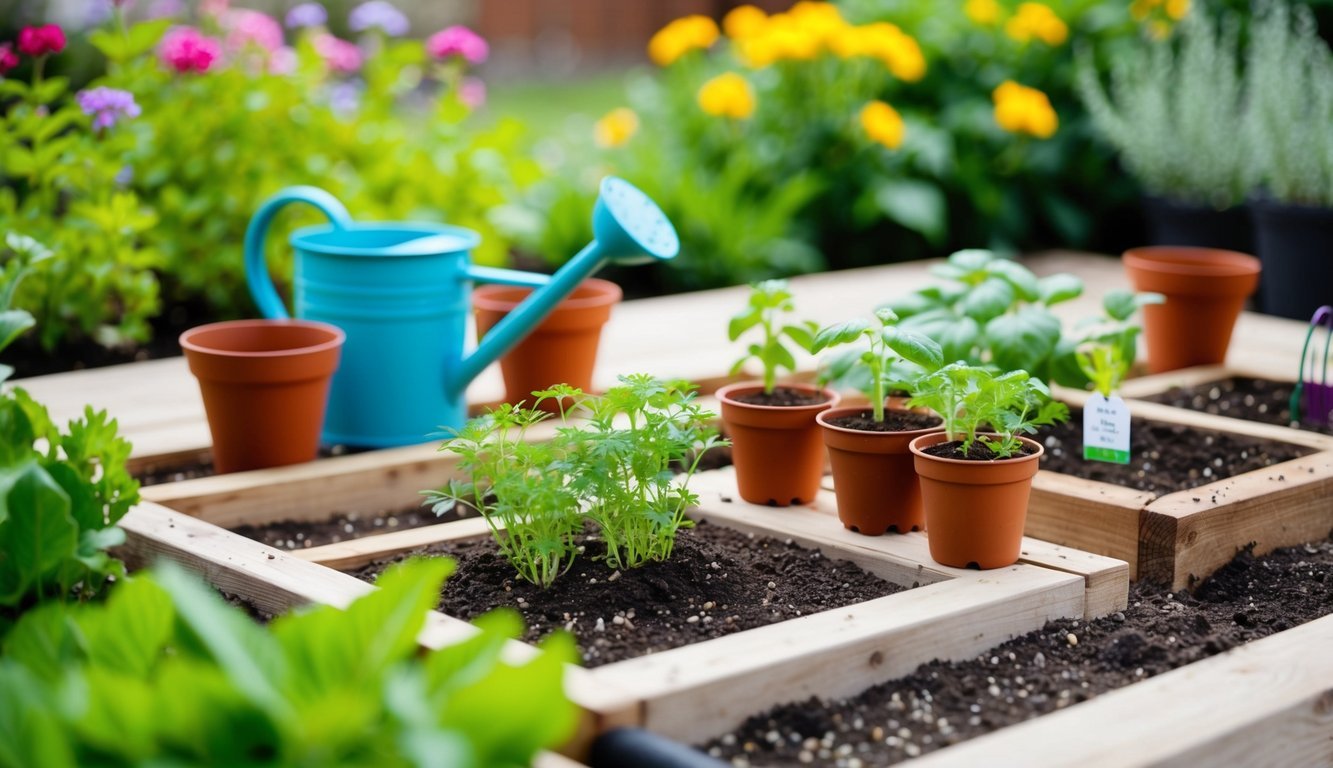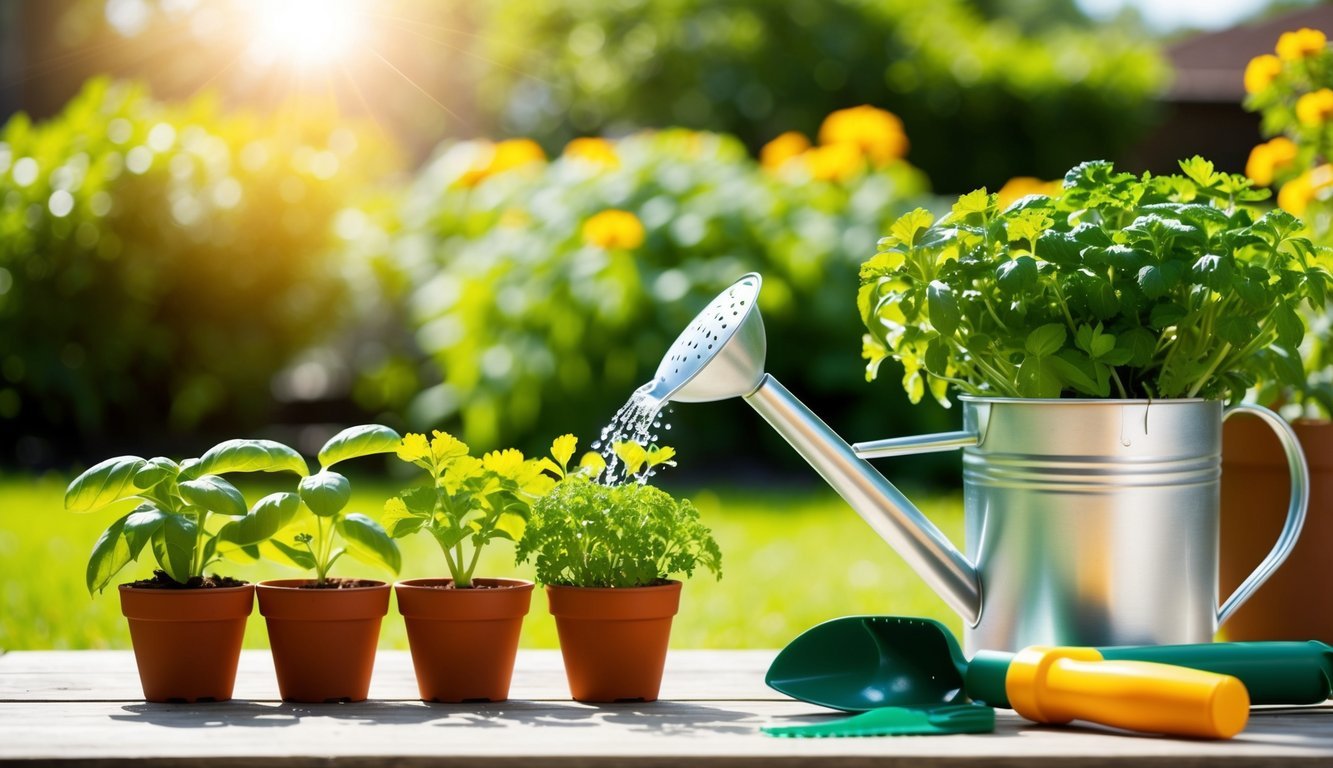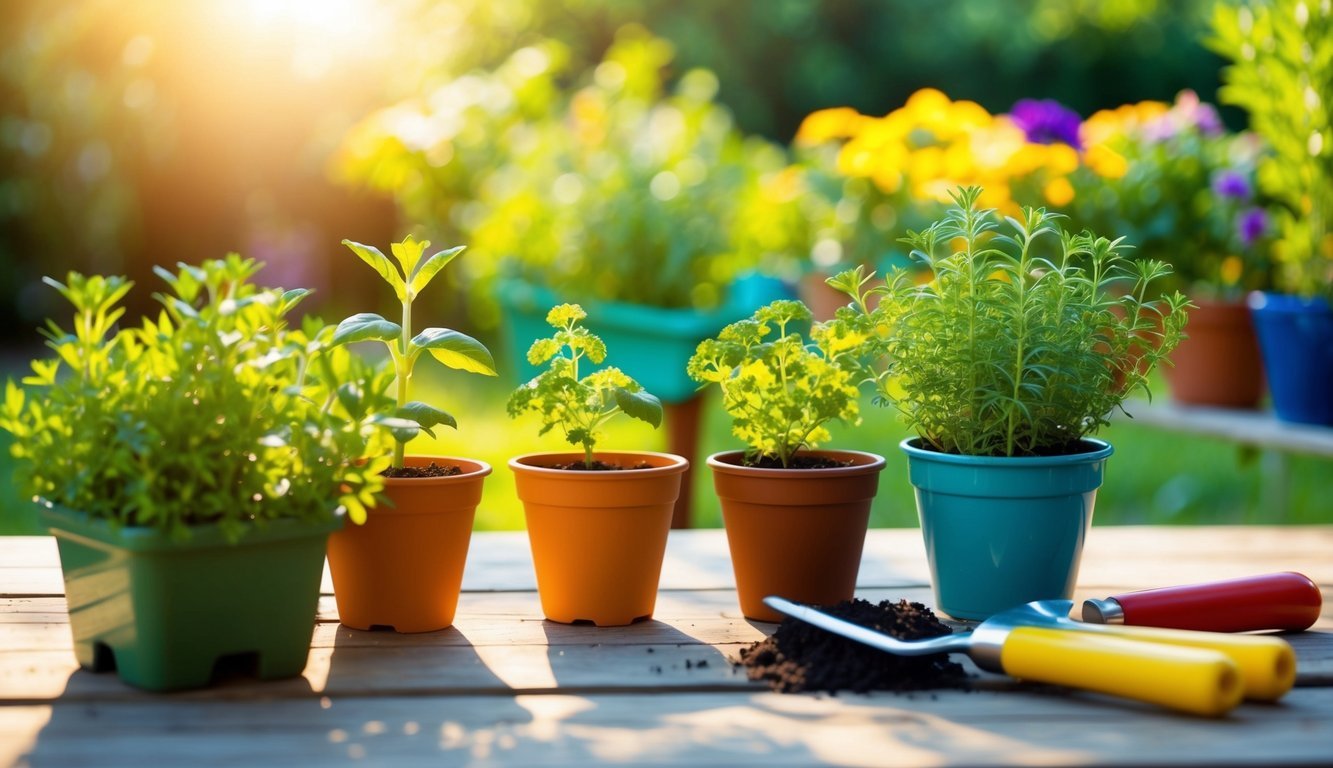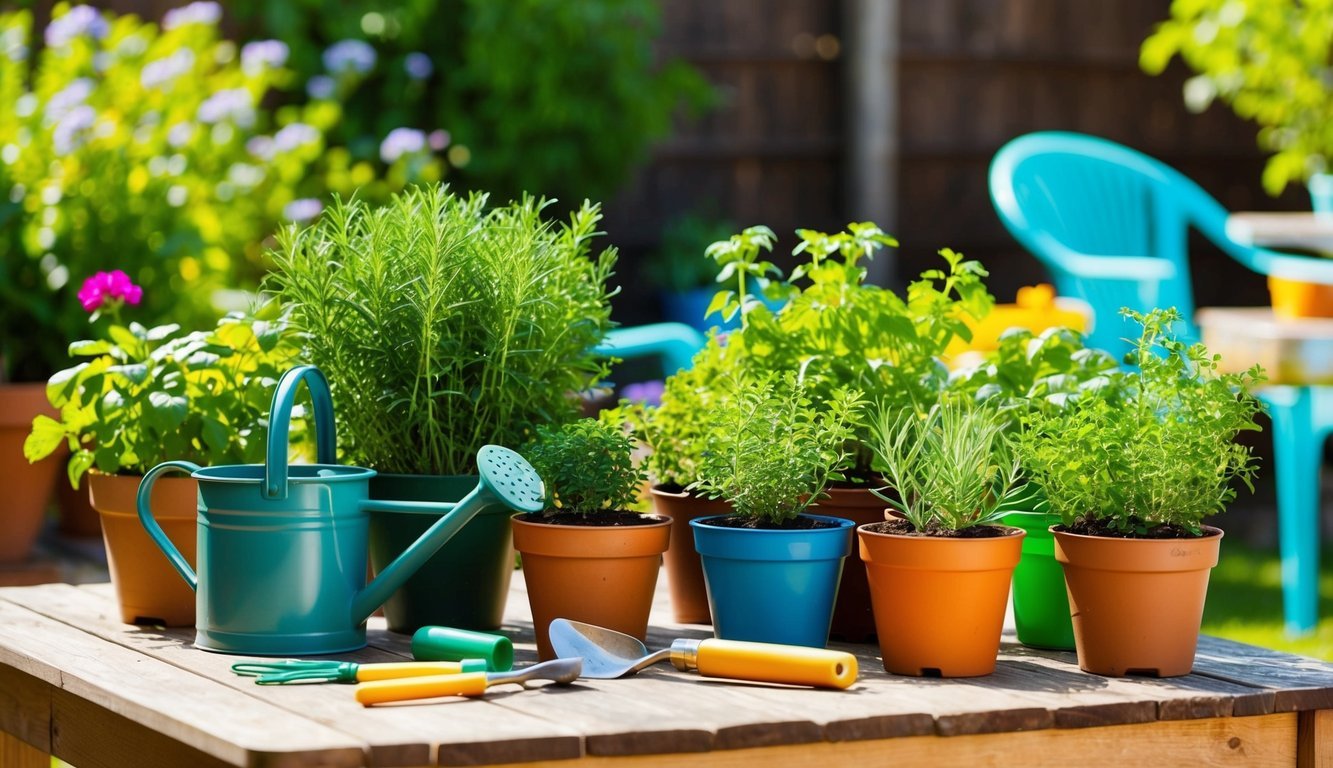Starting a herb garden with my kids has always been a rewarding adventure.
It’s not only a fun way to spend time together, but it also teaches them valuable lessons about nature and responsibility. Involving children in gardening helps them develop an appreciation for where their food comes from.
It also cultivates a sense of accomplishment as they watch their plants grow.

Herb gardening is straightforward and perfect for beginners, making it an excellent choice for family projects.
It’s easy to choose a few herbs that my kids enjoy, and the excitement of planting seeds or seedlings can spark their interest in the world around them. Engaging in this hands-on activity fosters creativity and curiosity while providing opportunities for learning and growth.
1) Choose Easy-to-Grow Herbs

When I started my herb garden with my kids, I focused on herbs that are simple to grow.
Basil, parsley, and mint are some of the best options.
They’re forgiving and tend to grow quickly, which keeps the kids excited.
Basil thrives in warm weather and is great for all those pizza nights.
It’s also fun to pinch off leaves, which encourages more growth.
Parsley is another fantastic choice.
It can handle a bit of shade and is a great way to introduce kids to healthy eating.
Plus, its vibrant green leaves are an attractive addition to the garden.
Mint is a personal favorite.
It spreads easily, which means a little goes a long way.
The kids love brushing their fingers against the leaves and enjoying the fresh aroma.
Choosing these easy-to-grow herbs made the experience enjoyable and successful.
Watching them grow together is rewarding and teaches kids about patience and care for plants.
Get Kid-Friendly Gardening Tools
Finding the right tools for kids can make gardening more enjoyable.
I look for tools that are smaller in size, designed specifically for little hands.
A child-sized trowel, rake, and watering can are essentials.
These make it easier for my kids to dig, plant, and water without getting frustrated.
Bright colors and fun designs can really capture their attention.
I often choose tools that are lightweight, so they can handle them more easily.
Safety is also a big factor.
I avoid sharp or heavy tools, focusing instead on those made from durable, safe materials.
Encouraging my children to color their tools or customize them adds a personal touch.
This way, they feel more attached to their gardening experience.
When my kids use their very own tools, it fosters a sense of responsibility and ownership.
It’s rewarding to see them excited about gardening with tools made just for them.
Select a Sunny Spot

Choosing the right location for our herb garden is key.
I look for a sunny spot that gets at least 6 hours of direct sunlight each day.
This is crucial for our herbs to thrive and grow well.
When scouting the area, I avoid places that are too windy.
A protected spot helps keep the plants safe from harsh breezes.
Next, I check for good drainage.
A location that doesn’t hold water will prevent our herbs from getting waterlogged.
I often test the soil to ensure it has a balanced pH, which should be slightly acidic to neutral, ideally between 6.0 and 7.0.
If space is limited, a sunny windowsill or balcony works too.
It’s all about getting creative and making the most of the sunlight available.
Finding the perfect spot can be a fun adventure for both me and my kids, and it’s the first step in our herb gardening journey.
Teach Planting Techniques
When teaching my kids to plant, I start with simple techniques to make it fun and engaging.
It’s important to show them how deep to plant seeds, demonstrating the right depth for different types of herbs.
I like to let them practice with their hands, feeling the soil and making little holes for the seeds.
Kids enjoy using small tools like trowels, which makes the process more interactive.
After planting, I emphasize the importance of watering.
I show them how to use a spray bottle for gentle watering.
This helps avoid moving the soil around and keeps the seeds in place.
To keep the experience exciting, I encourage them to decorate plant markers for each herb.
It adds a personal touch and helps them remember what they’ve planted.
Lastly, I remind my kids to find a sunny spot for the seeds.
A warm, bright area aids germination.
Watching the seeds sprout amazes them, making them eager to help care for the garden as it grows.
5) Encourage Regular Watering
Keeping herbs hydrated is key to a thriving garden.
I like to turn watering into a fun daily ritual with my kids.
We start each day by checking the soil.
If it feels dry about an inch down, it’s time to water.
I let my kids take turns with the watering can, making it feel like a special task.
I remind them to water at the base of the plants instead of on the leaves.
This way, the water goes straight to the roots where it’s needed most.
It helps to keep the leaves healthy and minimizes the risk of disease.
Sometimes, we check the weather forecast together.
If rain is expected, we leave the watering for the next day.
This not only saves us time but also teaches the kids about nature’s role in gardening.
Encouraging regular watering helps kids understand plant care.
Watching the herbs grow stronger each day builds a sense of responsibility and pride in their garden.
Choosing the Right Herbs

When starting a herb garden with children, selecting the right herbs is key to a successful and enjoyable experience.
I like to focus on herbs that are not only easy to grow but also engaging for kids.
Here are my top picks for kid-friendly options and those suitable for beginner gardeners.
Kid-Friendly Herb Selection
Some herbs are particularly appealing to kids due to their vibrant colors, distinct scents, and culinary uses.
Here are a few I recommend:
- Basil: This aromatic herb grows quickly and can be used in sauces and salads. Kids love its strong scent.
- Chives: These are easy to grow and add a mild onion flavor to dishes. The green, tall stalks are fun for kids to harvest.
- Mint: With its refreshing aroma, mint is great for teas and desserts. Kids enjoy squishing the leaves to release the fragrance.
Choosing these herbs can make gardening a more interactive and exciting experience.
Kids can enjoy the sensory aspects while they learn about plant growth.
Ideal Herbs for Beginners
For those of us who are new to gardening, focusing on resilient herbs helps build confidence.
I found that these herbs thrive with minimal care:
- Parsley: This biennial herb is forgiving of mistakes and adds flavor to many dishes. It’s easy for kids to recognize and appreciate in meals.
- Oregano: A staple in Italian cuisine, oregano grows well in various conditions and can survive through some neglect.
- Thyme: Known for its aromatic leaves, thyme is another hardy herb that kids can enjoy both in the garden and the kitchen.
These herbs require less maintenance and can adapt to various growing conditions, making them perfect for families starting out together.
Setting Up Your Garden
When starting a herb garden with kids, choosing the right space and tools is key.
I want to create an environment where we can learn and have fun.
Below are tips to consider for both indoor and outdoor gardens, along with essential tools to make the experience enjoyable.
Indoor vs Outdoor Spaces
Deciding between an indoor or outdoor garden is important.
For indoor gardens, look for a sunny windowsill or a spot with plenty of light.
Small pots work well, and I can use lightweight soil to make handling easier.
For outdoor gardening, a well-drained area is ideal.
I can use raised beds or containers if space is limited.
Having access to natural sunlight helps herbs flourish.
Remember to consider the climate; some herbs thrive better outdoors depending on the season.
A mix of both spaces can also work.
I can start seedlings indoors and then transfer them outside when they’re a bit stronger.
This way, each experience is unique and educational!
Essential Gardening Tools
The right tools make gardening easier and more fun.
A few essentials I recommend include:
- Small Trowel: Perfect for digging holes for herb plants.
- Watering Can: A small one is great for little hands to control.
- Gardening Gloves: Protect hands while helping kids avoid dirt under their nails.
- Seeds or Seedlings: Opt for kid-friendly herbs like basil or mint.
Using a measuring cup also helps ensure my plant roots receive the right amount of water.
Meanwhile, I like to have a notebook to track our garden’s growth and any observations.
These tools not only promote learning but also make the gardening process engaging for my kids.

